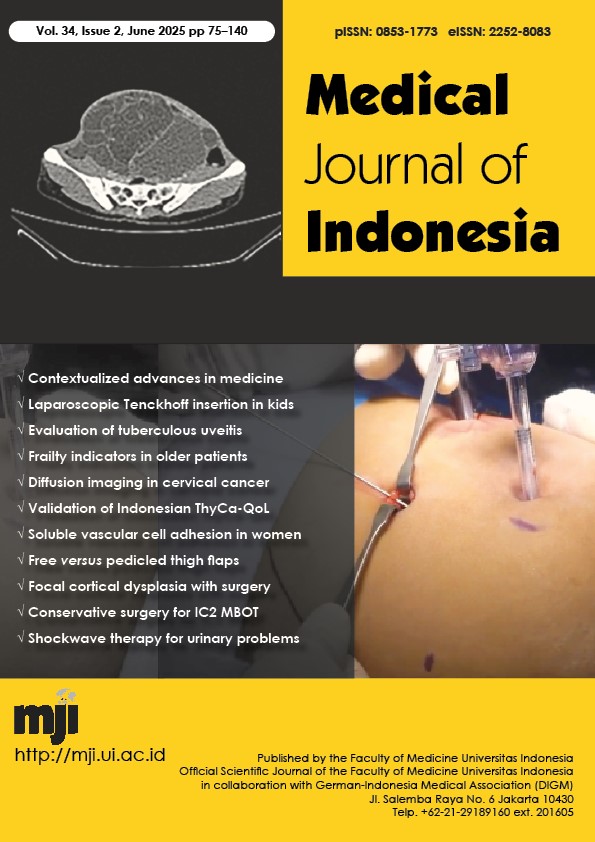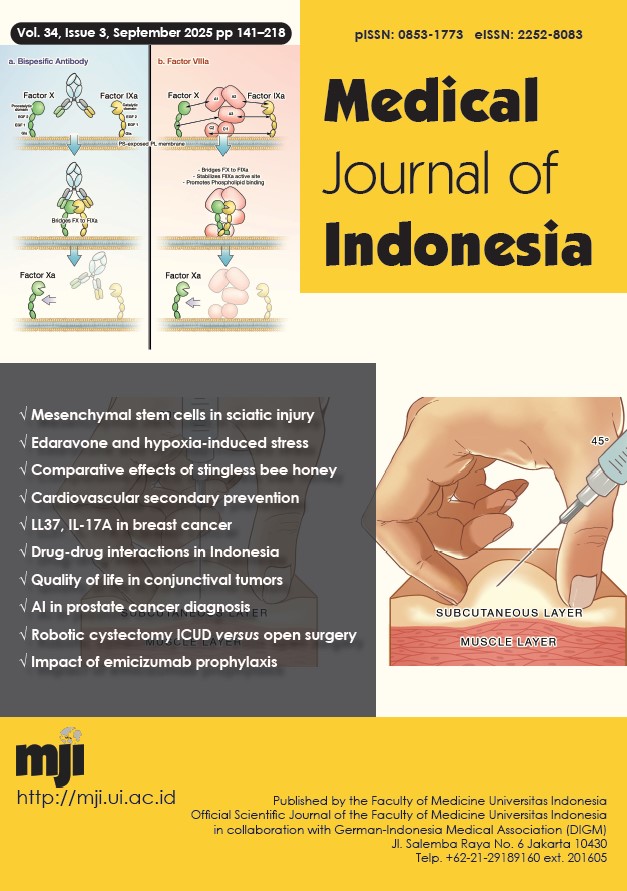Perianesthetic management in a teenager with focal cortical dysplasia who underwent an epilepsy surgery
DOI:
https://doi.org/10.13181/mji.cr.257555Keywords:
anesthesia, epilepsy, focal cortical dysplasia, surgeryAbstract
Medically resistant epilepsy (MRE) is defined as the failure of adequate trials of 2 tolerated and appropriately used antiepileptic drugs to achieve sustained seizure freedom, where epilepsy surgery (ES) is indicated in patients with MRE due to complex epileptic syndromes, such as Lennox-Gastaut and Sturge-Weber syndromes, and focal cortical dysplasia (FCD), to disconnect the epileptogenic foci from other cerebral structures. ES demands excruciating perianesthetic considerations due to its complexity and various pharmacological interactions. Our patient is a 15-year-old male with MRE secondary to FCD. He successfully underwent ES in our neurosurgical center. We describe our perianesthetic challenges in addition to a brief overview of MRE and FCD.
Downloads
References
GBD 2016 Epilepsy Collaborators. Global, regional, and national burden of epilepsy, 1990-2016: a systematic analysis for the Global Burden of Disease Study 2016. Lancet Neurol. 2019;18(4):357−75. Erratum in: Lancet Neurol. 2019;18(5):e4.
Fisher RS, Cross JH, French JA, Higurashi N, Hirsch E, Jansen FE, et al. Operational classification of seizure types by the International League Against Epilepsy: position paper of the ILAE Commission for Classification and Terminology. Epilepsia. 2017;58(4):522−30. https://doi.org/10.1111/epi.13670
Wirrell E, Tinuper P, Perucca E, Moshé SL. Introduction to the epilepsy syndrome papers. Epilepsia. 2022;63(6):1330−2. https://doi.org/10.1111/epi.17262
Banik S, Venkatraghavan L. Anesthesia for epilepsy surgery. In: Prabhakar H, Ali Z, editors. Textbook of neuroanesthesia and neurocritical care: volume I-neuroanesthesia. Singapore: Springer; 2019:159−70. https://doi.org/10.1007/978-981-13-3387-3_11
Fong SL, Lim KS, Tan L, Zainuddin NH, Ho JH, Chia ZJ, et al. Prevalence study of epilepsy in Malaysia. Epilepsy Res. 2021;170:106551. https://doi.org/10.1016/j.eplepsyres.2021.106551
Kim JS, Park EK, Shim KW, Kim DS. Hemispherotomy and functional hemispherectomy: indications and outcomes. J Epilepsy Res. 2018;8(1):1−5. https://doi.org/10.14581/jer.18001
Tsai JD, Chang YC, Lin LC, Hung KL; VNS TCNS. The neuropsychological outcome of pediatric patients with refractory epilepsy treated with VNS--A 24-month follow-up in Taiwan. Epilepsy Behav. 2016;56:95−8. https://doi.org/10.1016/j.yebeh.2015.12.030
Jobst BC, Cascino GD. Resective epilepsy surgery for drug-resistant focal epilepsy: a review. JAMA. 2015;313(3):285−93. https://doi.org/10.1001/jama.2014.17426
Mesraoua B, Brigo F, Lattanzi S, Abou-Khalil B, Al Hail H, Asadi-Pooya AA. Drug-resistant epilepsy: definition, pathophysiology, and management. J Neurol Sci. 2023;452:120766. https://doi.org/10.1016/j.jns.2023.120766
Jain P, Arya R. Vagus nerve stimulation and seizure outcomes in pediatric refractory epilepsy: systematic review and meta-analysis. Neurology. 2021;96(22):1041−51. https://doi.org/10.1212/WNL.0000000000012030
Garner GL, Streetman DR, Fricker JG, Bui NE, Yang C, Patel NA, et al. Focal cortical dysplasia as a cause of epilepsy: the current evidence of associated genes and future therapeutic treatments. Interdiscip Neurosurg. 2022;30:101635. https://doi.org/10.1016/j.inat.2022.101635
Jayalakshmi S, Nanda SK, Vooturi S, Vadapalli R, Sudhakar P, Madigubba S, et al. Focal cortical dysplasia and refractory epilepsy: role of multimodality imaging and outcome of surgery. AJNR Am J Neuroradiol. 2019;40(5):892−8. https://doi.org/10.3174/ajnr.A6041
Najm I, Lal D, Alonso Vanegas M, Cendes F, Lopes-Cendes I, Palmini A, et al. The ILAE consensus classification of focal cortical dysplasia: an update proposed by an ad hoc task force of the ILAE diagnostic methods commission. Epilepsia. 2022;63(8):1899−919. https://doi.org/10.1111/epi.17301
Dührsen L, Sauvigny T, House PM, Stodieck S, Holst B, Matschke J, et al. Impact of focal cortical dysplasia type IIIa on seizure outcome following anterior mesial temporal lobe resection for the treatment of epilepsy. J Neurosurg. 2018;128(6):1668−73. https://doi.org/10.3171/2017.2.JNS161295
Lotfinia M, Maloumeh EN, Asaadi S, Omidbeigi M, Sharifi G, Asadi B. Health-related quality of life after epilepsy surgery: a prospective, controlled follow-up on the Iranian population. Sci Rep. 2019;9(1):7875. https://doi.org/10.1038/s41598-019-44442-6
Nowak A, Bala A. Occult focal cortical dysplasia may predict poor outcome of surgery for drug-resistant mesial temporal lobe epilepsy. PLoS One. 2021;16(9):e0257678. https://doi.org/10.1371/journal.pone.0257678
Youngerman BE, Banu MA, Khan F, McKhann GM, Schevon CA, Jagid JR, et al. Long-term outcomes of mesial temporal laser interstitial thermal therapy for drug-resistant epilepsy and subsequent surgery for seizure recurrence: a multi-centre cohort study. J Neurol Neurosurg Psychiatry. 2023;94(11):879−86. https://doi.org/10.1136/jnnp-2022-330979
Fauser S, Essang C, Altenmüller DM, Staack AM, Steinhoff BJ, Strobl K, et al. Long-term seizure outcome in 211 patients with focal cortical dysplasia. Epilepsia. 2015;56(1):66−76. https://doi.org/10.1111/epi.12876
Carter EL, Adapa RM. Adult epilepsy and anaesthesia. BJA Educ. 2015;15(3):111−7. https://doi.org/10.1093/bjaceaccp/mku014
Maragkos GA, Geropoulos G, Kechagias K, Ziogas IA, Mylonas KS. Quality of life after epilepsy surgery in children: a systematic review and meta-analysis. Neurosurgery. 2019;85(6):741−9. https://doi.org/10.1093/neuros/nyy471
Widjaja E, Jain P, Demoe L, Guttmann A, Tomlinson G, Sander B. Seizure outcome of pediatric epilepsy surgery: Systematic review and meta-analyses. Neurology. 2020;94(7):311−21. https://doi.org/10.1212/WNL.0000000000008966
Sheng J, Liu S, Qin H, Li B, Zhang X. Drug-resistant epilepsy and surgery. Curr Neuropharmacol. 2018;16(1):17−28. https://doi.org/10.2174/1570159X15666170504123316
Published
How to Cite
Issue
Section
License
Copyright (c) 2025 Boon Tat Yeap, Thai Hau Koo, Song Yee Ang, Mohamad Hasyizan Hassan

This work is licensed under a Creative Commons Attribution-NonCommercial 4.0 International License.
Authors who publish with Medical Journal of Indonesia agree to the following terms:
- Authors retain copyright and grant Medical Journal of Indonesia right of first publication with the work simultaneously licensed under a Creative Commons Attribution-NonCommercial License that allows others to remix, adapt, build upon the work non-commercially with an acknowledgment of the work’s authorship and initial publication in Medical Journal of Indonesia.
- Authors are permitted to copy and redistribute the journal's published version of the work non-commercially (e.g., post it to an institutional repository or publish it in a book), with an acknowledgment of its initial publication in Medical Journal of Indonesia.






































